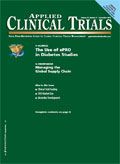Implications of Biosimilar Development
Applied Clinical Trials
Demonstrating biosimilarity is highly dependent on the unique characteristics of the product.
The recent US Food and Drug Administration (FDA) guidances on biosimilars provided the industry with insight and perspective on biosimilar product development. While the new guidelines don't address product specific questions, they do provide key points for consideration that apply across all biosimilar development programs.

Dirk Reitsma, MD
More specifically, there are three key points in the guidances that summarize the FDA's position on assessing biosimilarity. They include development of a stepwise approach, minimizing residual uncertainty, and the evaluation of biosimilarity based on the totality of data.
The specific requirements for demonstrating biosimilarity to a reference product are highly dependent upon the unique characteristics of the biosimilar product and the robustness of the comparability data amassed in each step of the development process. The FDA has outlined a stepwise approach to biosimilar development that starts with extensive physical, chemical, and biological characterization of the proposed biosimilar. This characterization should then be followed by comprehensive structural and functional comparability assessment of the biosimilar to the reference product. These initial assessments provide the foundation for the remaining biosimilar development program. The willingness of regulators to accept an abbreviated preclinical and clinical development program will depend upon the robustness of analytical structural and functional comparability data. Initial assessments are critical for determining the extent of the clinical program that will be required for establishing similarity. Biosimilars that are highly comparable to the reference product may call for leaner or abbreviated pre-approval clinical data packages.
The competitive environment for developing biosimilars has placed a premium on speed and efficiency. As a result, companies are searching for ways to shorten the biosimilar development process while ensuring they meet scientific and regulatory requirements. With this goal in mind, biosimilar developers should assimilate the concept of seamlessly reducing residual uncertainty as they conduct their biosimilar development programs. Companies should start this process in the analytical comparability phase of development and strive to reduce the product's residual uncertainty as much as possible before meeting with regulatory agencies to discuss their preclinical and clinical programs.
There are many important factors to consider when developing biosimilars such as the choice of reference product that is used in similarity assessments. The European Medicine Agency's (EMA) draft guidance states that the reference product used for similarity assessments must be the product approved in the EMA's jurisdiction. However, the language in the FDA draft guidance does allow for data generated from non-US approved reference products to be used in support of a US submission, but bridging studies will likely be necessary. The FDA will assess the data that is submitted in the marketing application in its totality, allowing for data generated by either US approved or non-US approved reference products.
In summary, the FDA's draft guidances provide the industry with significant insight into the agency's expectations for conducting biosimilar development programs along with the data required for demonstrating similarity. It also outlines how the agency will review data during the development phase and marketing application review process.
Dirk Reitsma, MD Vice President Global Product Development PPD E-mail: ppdinfo@ppdi.com

Improving Relationships and Diversifying the Site Selection Process
April 17th 2025In this episode of the Applied Clinical Trials Podcast, Liz Beatty, co-founder and chief strategy officer, Inato, discusses a number of topics around site engagement including community-based sites, the role of technology in improving site/sponsor relationships, how increased operational costs are impacting the industry, and more.